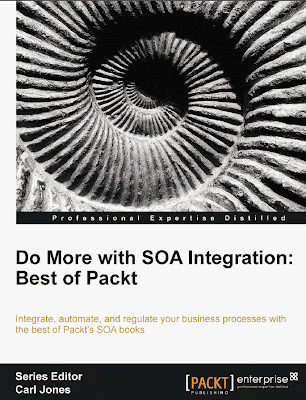
Link 2 Book on PacktPub
This is a compendium from industry experts including Oracle's own Harish Gaur, Tom Laszewski, Antony Reynolds, Jason Williamson, Markus Zirn. There are also contributions from Oracle Aces such as Guido Schmutz and Matt Wright.
Chapter 1 covers the basic principles of integration architecture, including a section on Patterns for service-oriented integration.
Chapter 2 goes into detail on Integration Architecture, Principles, and Patterns. This includes a very interesting section on Integration Infrastructure.
The next chapter covers the base technologies - JCA, SCA, JBI, SDO. It concludes with a section covering Process Modeling - EPC, BPMN and BPEL.
Chapter 4 is a gem, covering as it does - Best Practices for Using XML for Integration. Lots of useful tips here.
The next chapter deals with leveraging BPEL to integrate with other EAI solutions. The case study covers integration with TIBCO BusinessWorks and webMethods.
Chapter 6 covers integration with the 2 leading ERP systems - Oracle Apps and PeopleSoft.
Chapter 7 introduces us to the concept of JBI service engines and the raison d'être for NMR(Normalized Message Router). It then goes on to discuss the offering that comes with the NetBeans Enterprise Pack. To quote - "The NetBeans Enterprise Pack provides a version of the Sun Java System Application Server 9.0 which includes several Service Engines from the Open ESB project." The following chapter covers the binding components within the NetBeans environment. Among those discussed are File BC, SMTP BC, SOAP BC, JDBC BC, JMS BC, FTP BC.
Chpater 9 is titled SOA and Web Services Approach for Integration. It begins by discussing how to design Service-Oriented Architectures and then moves on to the heuristics of designing Web Services. The differences between B2B and EAI Web Services are discussed which leads on nicely to the concluding section on Interoperable WSDL.
Chapter 10 discusses ESB architecture, positioning it succinctly as the middleware for middleware technologies. It also focuses heavily on the key requirements of scalability, reliability and security.
Chapter 11 is titled - Loosely Coupling Services - and explores how service virtualization through the Oracle Service Bus (OSB) can be leveraged to ensure more loosely coupled services.
Chapter 12 covers - Integrating BPEL with BPMN using BPM Suite. the focus is on Oracle SOA Suite and how one can implement an SCA composite that includes both BPEL and BPM. Human interaction via BPM, back end service integration via BPEL.
The penultimate chapter, 13, covers - SOA Integration—Functional View, Implementation, and Architecture. Here SOA is discussed in the context of modernization - Legacy SOA Integration. To quote - "SOA Integration is a combined data federation and remote method invocation approach to solve EII/EAI in a Legacy Modernization project." So for those of you concerned with this space, this chapter is a must!
The final chapter - SOA Integration—Scenario in Detail, covers an implementation of the concepts from the previous chapter. To quote "We are now going to show an example in detail for—Web Enablement. We will use JSP, JDBC, the Oracle Legacy Adapter, Oracle Application Server, Java EE Connector API, and XA transaction processing to show a two-phase commit across an Oracle database and VSAM on the mainframe." A great real-world example of SOA in action.
All in all, a great read from those who really know what they are talking about!
Take a bow guys!



No comments:
Post a Comment